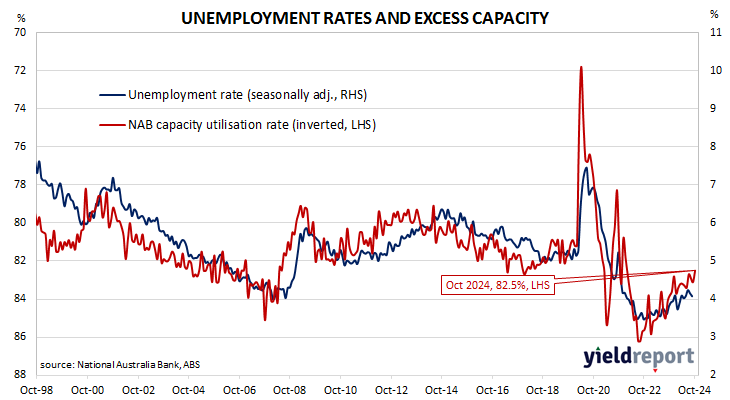Summary: Business conditions steady in October; business confidence improves markedly, back to average; NAB: confidence spikes, an encouraging sign; short-term ACGB yields increase, longer-term yields decline; rate-cut expectations soften; NAB: survey continues to suggest ongoing gradual easing in inflation pressure; capacity utilisation rate falls.
NAB’s business survey indicated Australian business conditions were robust in the first half of 2018, with a cyclical-peak reached in April of that year. Readings from NAB’s index then began to slip and forecasts of a slowdown in the domestic economy began to emerge in the first half of 2019 as the index trended lower. It hit a nadir in April 2020 as pandemic restrictions were introduced but then improved markedly over the next twelve months and has subsequently remained at robust levels until recently.
According to NAB’s latest monthly business survey of around 350 firms conducted in the last week of October, business conditions have remained steady at a level in line with the long-term average. NAB’s conditions index registered 7 points, unchanged from September’s reading.
At the same time, business confidence improved markedly. NAB’s confidence index rose 7 points to +5 points, a reading which is also in line with its long-term average. NAB’s confidence index typically leads the conditions index by one month, although some divergences have appeared from time to time.
“Confidence spiked in the month after an extended period of below-average reads,” said NAB Head of Australian Economics Gareth Spence. “While it’s just one month this is an encouraging sign alongside a tentative improvement in forward orders.”
The figures came out on the same day as the latest Westpac-Melbourne Institute consumer sentiment survey and short-term Commonwealth Government bond yields increased modestly while longer-term declined a little. By the close of business, the 3-year ACGB yield had added 1bp to 4.11%, the 10-year yield had slipped 1bp to 4.58% while the 20-year yield finished 2bps higher at 4.88%.
Expectations regarding rate cuts in the next twelve months softened, with a February cut now viewed as not especially likely. Cash futures contracts implied an average of 4.335% in November, 4.315% in December and 4.29% in February 2025. October 2025 contracts implied 3.96%, 38bps less than the current cash rate.
“We continue to watch the survey closely, not just for the forward looking and activity indicators but also capacity utilisation which will be key in the evolution in price pressures for the economy,” added Spence. “The survey, like other price indicators, continues to suggest an ongoing gradual easing in inflation pressure but also that there is still some way to go in in the inflation moderation when we look at the consumer facing components.”
NAB’s measure of national capacity utilisation fell back from September’s reading of 83.1% to 82.5%, a level which is still quite robust from a historical perspective. Five of the eight sectors of the economy were reported to be operating at or above their respective long-run averages.
Capacity utilisation is generally accepted as an indicator of future investment expenditure and it also has a strong inverse relationship with Australia’s unemployment rate.



